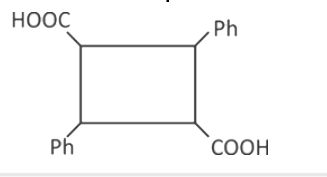The number of optical isomers of the compound CH3CHBrCHBrCOOH is
0
1
3
4
The correct Answer is:D
To determine the number of optical isomers of the compound CH3CHBrCHBrCOOH, we can follow these steps:
Step 1: Identify the Structure
The compound can be represented structurally as follows:
- The compound has a chain of four carbon atoms.
- There are two bromine (Br) substituents on the second and third carbon atoms.
- There is a carboxylic acid group (-COOH) on the last carbon.
Step 2: Determine Chirality
A carbon atom is considered chiral if it has four different substituents. In this compound:
- The second carbon (C2) has the substituents: H, Br, CH3, and the carbon chain (C3).
- The third carbon (C3) has the substituents: H, Br, C2, and the carboxylic acid group (COOH).
Both C2 and C3 are chiral centers because they each have four different groups attached to them.
Step 3: Count the Chiral Centers
We have identified that there are 2 chiral centers in the compound (C2 and C3).
Step 4: Calculate the Number of Optical Isomers
The formula to calculate the number of optical isomers is given by:
Number of optical isomers=2n
where n is the number of chiral centers.
In this case, n=2:
Number of optical isomers=22=4
Conclusion
Thus, the total number of optical isomers for the compound CH3CHBrCHBrCOOH is 4.
---
The compound can be represented structurally as follows:
- The compound has a chain of four carbon atoms.
- There are two bromine (Br) substituents on the second and third carbon atoms.
- There is a carboxylic acid group (-COOH) on the last carbon.
A carbon atom is considered chiral if it has four different substituents. In this compound:
- The second carbon (C2) has the substituents: H, Br, CH3, and the carbon chain (C3).
- The third carbon (C3) has the substituents: H, Br, C2, and the carboxylic acid group (COOH).
We have identified that there are 2 chiral centers in the compound (C2 and C3).
The formula to calculate the number of optical isomers is given by:
Number of optical isomers=2n
where n is the number of chiral centers.
Number of optical isomers=22=4
Thus, the total number of optical isomers for the compound CH3CHBrCHBrCOOH is 4.
Topper's Solved these Questions
- BOOK - R SHARMACHAPTER - STEREOCHEMISTRYEXERCISE - Level IV19videos
STEREOCHEMISTRY
- BOOK - R SHARMACHAPTER - STEREOCHEMISTRYEXERCISE - Archives17videos
STEREOCHEMISTRY
- BOOK - R SHARMACHAPTER - STEREOCHEMISTRYEXERCISE - Level II25videos
STEREOCHEMISTRY
- BOOK - R SHARMACHAPTER - SOLUTIONSEXERCISE - ARCHIVES42videos
SOLUTIONS
- BOOK - R SHARMACHAPTER - SURFACE CHEMISTRYEXERCISE - Archives18videos
SURFACE CHEMISTRY
Similar Questions
Knowledge Check
- Question 1 - Select One
The number of optical isomers of the compound.
CH3−CHBr−CHBr−COOH is:A0B1C3D4 - Question 2 - Select One
The number of enantiomers of the compound CH3CHBrCHBrCOOH is
A0B1C3D4 - Question 3 - Select One
The number of enantiomers of the compound CH3CHBrCHBrCOOH is
A0B1C3D4
Number of optical isomers possible for
 View Solution
View SolutionThe number of optical isomers for the compound, CH3−CH(Br)−CH(Br)C2H5 is
View SolutionThe number of asymmetric carbons and number of optical isomers the compound CH3(CHOH)2COOH can form are respectively
View SolutionNumber of optical isomers of lactic acid are
View SolutionFind the number of optical isomers for this sizes compound.
 View Solution
View Solution

